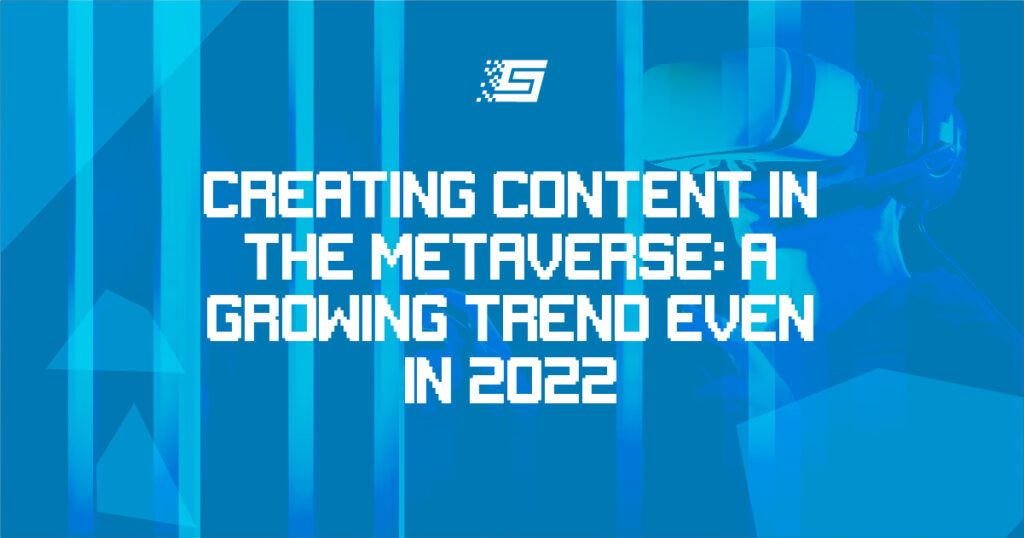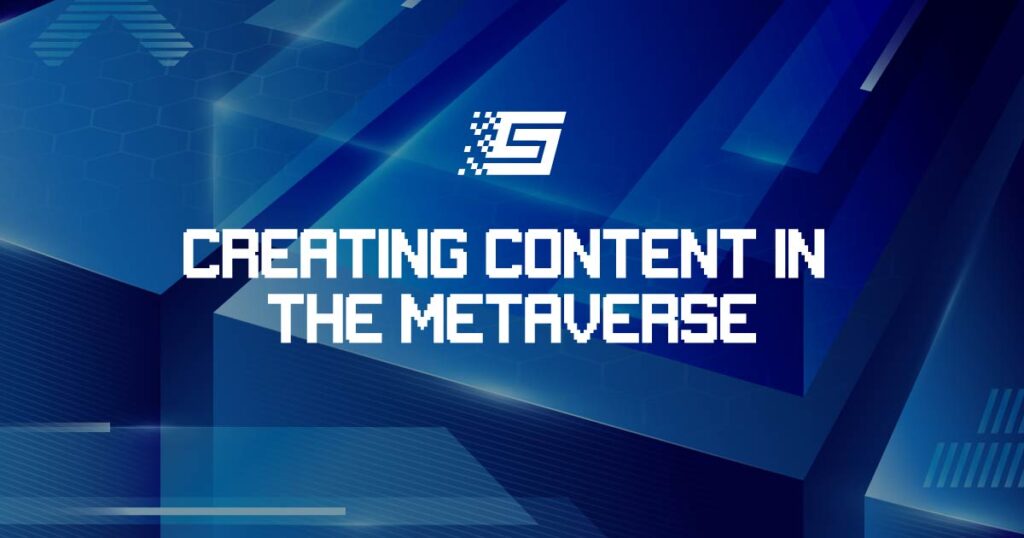
Creating Content In The Metaverse: A Growing Trend
As with all new online environments, the metaverse needs content, and those who provide it will have access to powerful tools that allow them to create impressive and interactive experiences for their audiences.
Step by step, these developing online ecosystems will transform into an interactive network of three-dimensional virtual worlds (known as the metaverse) connecting people and brands via online experiences and activities. This will usher in a new series of daily online interactions for individuals regarding their commerce habits, social life, professional growth, and everything in between. We can consider it as the next step of today’s internet (or web2), which will see every sector of the digital economy gradually alter its ways of operation. But there is one group that will undoubtedly benefit from the metaverse’s strong disruption throughout: all creators.
How Will The Metaverse Transform Content Creation?
The metaverse has focused on a creator ecosystem because it needs a great army of talent that is ready to create interactive and immersive content, which is thanks in large part to advances in VR (virtual reality) and AR (augmented reality). Day by day we see the demand double its force upon the content creator community as they are expected to produce more immersive and interactive content for virtual worlds than ever before.
In the near future, creators will not only be the working force for producing traditional 2D content but also creating new ways and tools of making this content more responsive and interactive through online media. New content will be fundable and reachable mostly through digital media.
Today’s interactive content will eventually be altered into a 3D world for consuming new content via podcasters, Youtubers, TikTokers, designers, artists, and so on. The creators will produce digital replicas (avatars) of themselves and their existing environments (studios, workplaces, homes, etc.) where they will be able to interact with their online visitors for everyday and/or professional activities. Imagine doing your weekly grocery shopping by sending an avatar to the local online supermarket.
Creators will work with AI-assisted tools that give them the skills to translate a high-level vision into appealing interactive content ready for consumption. This may involve AI-assisted animation, AI-powered video editing, or even AI-powered music composition.
Metaverse Content Creators Are On The Rise. Just How Accurate Is This?
According to CoinTelegraph, over 50 million creators are feeding online economies with their talent and ideas.
The metaverse provides new opportunities for creators and their $104 billion creator economy. For instance, musicians are able to host fully virtual concerts on the metaverse that will bring audiences from all over the world without geographical limitations. Artists can create and sell 3D art to display on the walls of virtual buildings in the metaverse.
A range of technology companies — from big players such as Microsoft and Google to smaller ones like Niantic and Emblematic — have already begun building experiences and products for the metaverse. Early versions of it already exist in the form of virtual worlds of games like Roblox, Minecraft, and Fortnite. It incorporates technologies like VR and AR that, while still young, have been in use for some time.
Different Ways To Create Content In The Metaverse
If you wanted to create content in the metaverse, you could use Roblox to sell your own digital products for avatars. Brands such as Gucci and Adidas have already created their own digital brands within Roblox, and Nike has jumped into the metaverse with ‘Nikeland,’ a Roblox virtual world. These are just a few examples — the possibilities are endless.
How to sell in the metaverse?
For starters, you could replicate a physical retail experience with a virtual venue and sell products through your virtual shop. Within these virtual spaces alone, you can offer a variety of experiences, which include:
- Virtual try-outs of products
- Try-ons of clothing
- Tours
- Showrooms
In addition to bringing people into virtual spaces, you can add virtual elements to these spaces using AR technology. Also, a number of fashion brands are selling virtual clothing and accessories for avatars to wear. As a content creator, you may want to create virtual items for digital avatars.
Complementing virtual spaces, the metaverse can be used to hold various virtual events and create various other immersive experiences.
Google has begun experimenting with its project called the Glass Product, which is connecting people through augmented avatars bringing together the digital and physical worlds. It has laid the foundation but must take it on more actively. According to Google’s CEO Sundar Pichai, the metaverse is “evolving computing in an immersive way with augmented reality.”
Meta is showing its serious involvement in this new realm with a variety of projects on Oculus VR, Facebook, and Instagram, all under its main brand:
VR Messaging — helps connect users in an immersive way.
Project Cambria — a VR headset compatible with the Oculus Quest VR world.
Horizon Worlds Marketplace — a place where buyers, sellers, and creators can exchange digital goods.
The marriage of content creators, the metaverse & NFTs
An NFT (non-fungible token) is a type of cryptographic token on the blockchain that represents a unique asset. These tokens can either be entirely digital assets or tokenized versions of real-world assets. As NFTs are not interchangeable with each other, they can function as proof of authenticity and ownership in the digital realm.
Fungibility means an asset’s individual units are interchangeable and essentially indistinguishable from each other. Fiat currencies, for example, are fungible as each unit is interchangeable with any other equivalent individual unit. Ten-dollar bills are interchangeable with any other genuine ten-dollar bills. This is imperative for assets that aim to act as a medium of exchange.
Fungibility is a desirable property for currencies because it enables free exchange, and theoretically, there is no way of knowing the history of each individual unit. However, that isn’t a beneficial trait for collectible items.
If we could create digital assets that are similar to Bitcoin but instead add a unique identifier to each unit, that would make each of them different from all the other units (i.e., non-fungible). This is essentially what an NFT is.
The Metaverse World Is Here To Stay
For people to want to use these new technologies, they will have to feel safe. Companies like Meta will have a lot of work to do building the credibility of the metaverse as an idea, and also to demonstrate to people that they are committed to building it in a responsible way.
We have to take this next step without losing the right to protect our lives from invasive technologies. Being open and transparent about the work that metaverse-related companies are doing should be a requirement before it is implemented into our everyday activities.
Making The Metaverse: How It Will Be built, And Why It Matters
Nick Clegg, President of Global Affairs at Meta says: “The metaverse is still in an early stage of its development. There is nothing deterministic about the way a new technology impacts society. Technology is not good or bad in and of itself. People will ultimately use it as they see fit — and misuse it as well. Just as we have seen how the problems in our physical society have manifested on the internet, they would reoccur in any system or platform regardless of who builds it or what it is. That’s why we must create thoughtful rules and have guardrails in place as the metaverse develops in order to maximize the potential for good and minimize potential harms.”
“There will be various low-cost entry points to the metaverse — including mobile phones — but to buy VR headsets, some level of cost will be unavoidable. Part of Meta’s efforts is to ensure it is actively considering diversity, equality, and inclusivity as it works to help build the metaverse; we are determined to make our headsets as affordable as possible.“
A white paper that was produced for Meta by the independent economic consultancy Analysis Group estimates that the metaverse economy could be worth over $3 trillion globally in a decade.
“An industry that massive would also be a job creation engine — and these jobs would not be limited to the campuses of Silicon Valley. Back in 2020, the mobile technology sector directly employed around 12 million people globally, and employed another 13 million people indirectly.”
“The metaverse economy won’t just include the industries that create its infrastructure, like payment systems, hardware, software, and broadband providers, but also sectors such as e-commerce, education, gaming, and more that will provide goods and services associated with it. When social spaces are created in the metaverse, people will need to be hired to manage and maintain them, just like in the physical world.”


